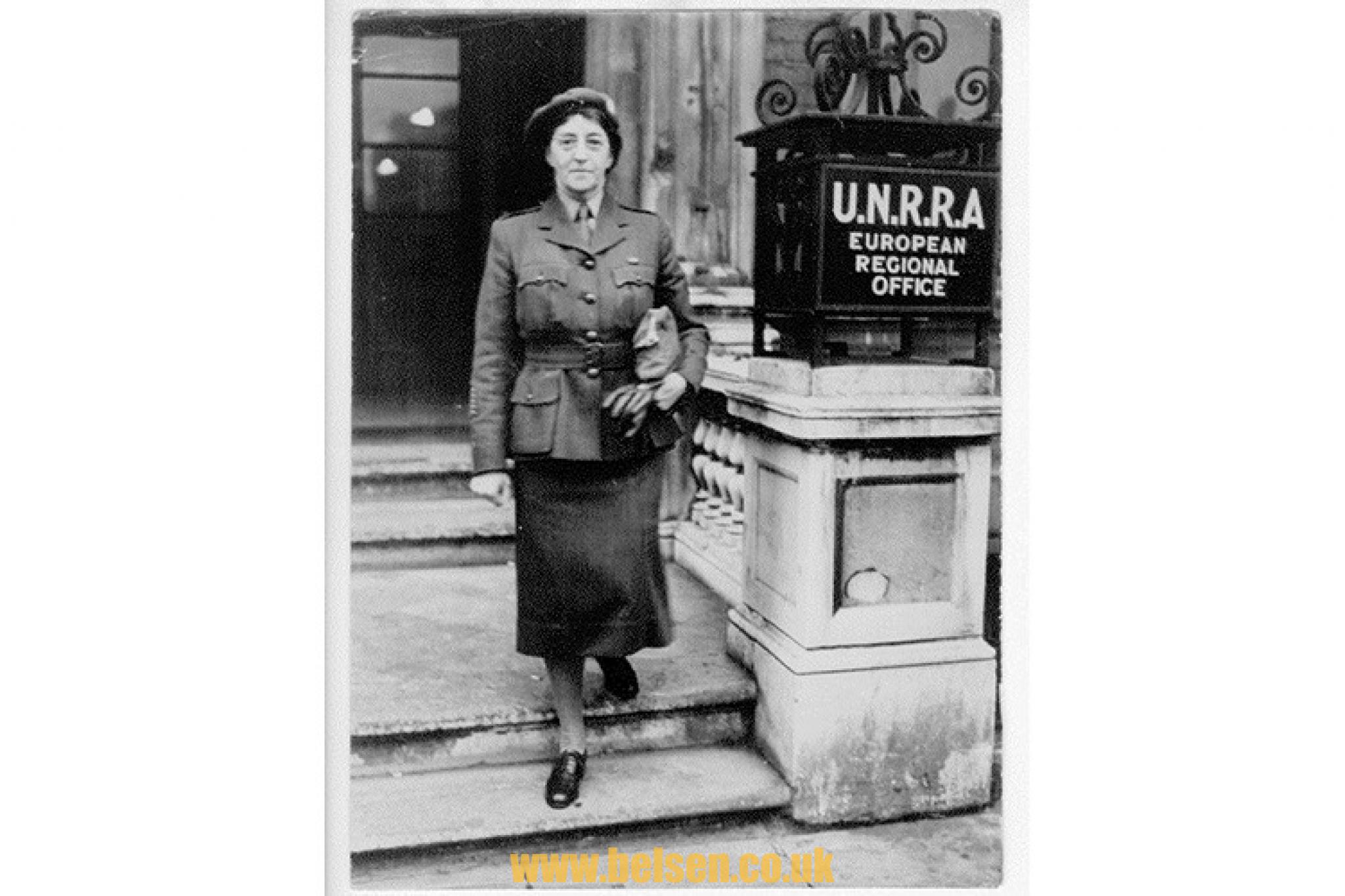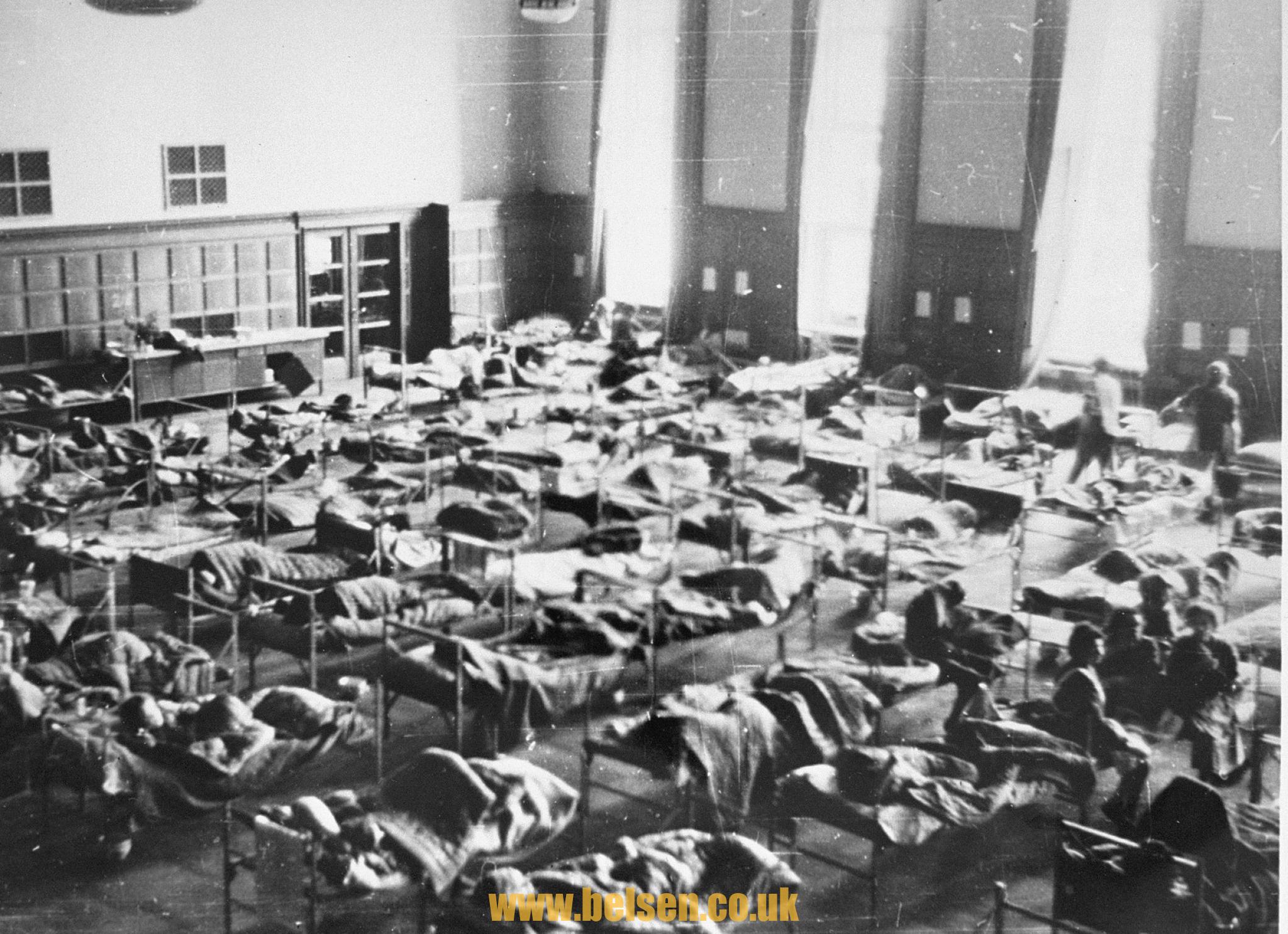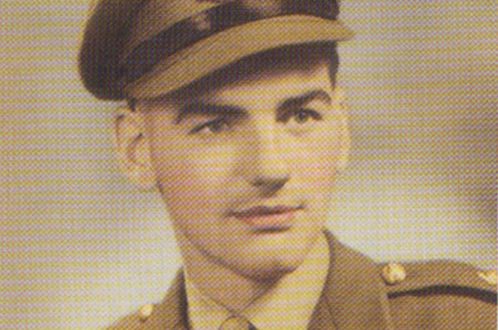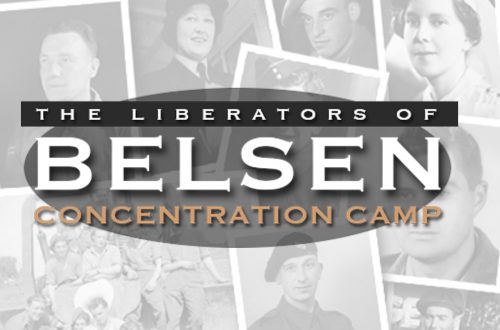Muriel Knox Doherty (Matron)
At the outbreak of the Second World War, Muriel Knox Doherty was appointed matron of the No.3 RAAF Hospital in Richmond, New South Wales. An already distinguished Sydney nurse, she helped to establish the Royal Australian Air Force Nursing Service (RAANS) in New South Wales and Queensland from 1940 – 1944 and co-authored one of the first Australian nursing textbooks Modern Practical Nursing Procedures in 1944. Muriel was awarded the Royal Red Cross Medal (1st Class) for her work. Arrived at Belsen Camp on July 11th 1945.
 Enthusiastic to provide aid in Europe, Sister Doherty arrived in Germany on 11 July 1945 as Principal Matron for the United Nations Relief and Rehabilitation Administration (UNRRA), along with Senior Medical Officer Dr T.V.Layton. The Bergen-Belson Concentration Camp had been liberated from the Nazis some months before. British troops were faced with more than 40,000 desperately starving and ill men, women and children and more than 10,000 unburied dead. In addition to the 50,000 who had already perished, 13,000 would die from malnutrition and disease in the weeks following the liberation. After the mammoth task of evacuating survivors, British forces destroyed the camp by fire to prevent the spread of typhus.
Enthusiastic to provide aid in Europe, Sister Doherty arrived in Germany on 11 July 1945 as Principal Matron for the United Nations Relief and Rehabilitation Administration (UNRRA), along with Senior Medical Officer Dr T.V.Layton. The Bergen-Belson Concentration Camp had been liberated from the Nazis some months before. British troops were faced with more than 40,000 desperately starving and ill men, women and children and more than 10,000 unburied dead. In addition to the 50,000 who had already perished, 13,000 would die from malnutrition and disease in the weeks following the liberation. After the mammoth task of evacuating survivors, British forces destroyed the camp by fire to prevent the spread of typhus.
Muriel wrote extensive ‘Community Letters’ to family and friends in Sydney, recording her insights of the camp and the extraordinary suffering she witnessed:
“We drove past vast areas of burnt out huts with only the charred remains & a few odd bits of china & rusted & burnt metal to mark the site. Enormous graves holding from 500 to 8,000 bodies each are grim reminders of Nazi brutality. Practically no children under two survive. A crematorium complete with metal stretcher and long handled metal stoker, nearby, needs no explanation. No babies born in camp were allowed to live. An enormous pile of half burnt out leather boots & shoes, marks the place where they were dumped by the Germans to be used as fuel. The pump where so many were beaten to death as they crawled in search of water, was evident.”

Sister Doherty went on to assist thousands of survivors at the Bergen-Belsen displaced persons camp established nearby to the ruins. On 27 July 1945, she wrote to her friends:
“The work facing the liberators must have at first appeared insurmountable and praise is too high for those men and women who by their courage, energy, initiative & enthusiasm, brought to the survivors of this horror, tragedy and suffering, food & drink, cleanliness and sympathy and some glimmer of hope for the future.”
After returning to Sydney, Muriel resided for a time at the Queen Mary Nurses’ Home at Royal Prince Alfred Hospital and co-founded both the New South Wales College of Nursing (today the Australian College of Nursing) in 1949 and the Civilian Nursing Services Bureau. She died in 1988 at the age of 92.
***
Letter
Page 1]
(Belsen No 2)
Community Letter 6
6 Belsen Camp
N.W. Germany
8.8.45
My dear Friends,
You will have received my last letter giving you details of the early history of Belsen – This will give you some idea of the conditions prevailing before & up to my arrival & I hope future letters will then give you a picture of present day conditions & progress. The early days of phase 2 were those of intense and exhausting work for the staff, and of miraculous change for the patients, Doctors, nurses, and all other personnel at the Camp were toiling from morn till night in the “wards” of the “Hospital blocks”, the “Round House” & later the “Glyn Hughes” Hospital – Mr Winston Churchill’s famous tribute to the R.A.F. in the Battle of Britain might well apply to these courageous people – “Never before have so many, owed so much to so few”.
I have met & talked with many of the original liberators and have been impressed by the modest way in which they narrate their experiences.
Feeding the victims of starvation & disease was in itself a colossal & & heartbreaking undertaking
[Page 2]
The moment food appeared, those who could, oblivious of their stark nakedness, staggered forward, gaunt spectres with arms outstretched, crying “Essen, essen”. In fact, that cry was incessant in the early days.
When organised feeding became possible in Camp 1, the liberators were sometimes criticised by these people for the small quantities served. Many felt that they were better off under the Germans, when they had their watery soup, potatoes &
chunk of dry bread. They were not in a fit mental condition to appreciate the fact that it was highly nutritional.
I am not in a position, at present, owing to the many changes in Medical & Nursing Staff since the day of liberation, to discuss the scientific feeding of these starving victims or+ the nutritional disorders associated with this condition. Intravenous feedings were given and casein hydrolysate used for large numbers suffering from starvation.
Col. V.P. Sydenstricker, Head of the Nutrition Section, Health Division, UNRRA, and Dr. C.N. Leach of the
[Page 3]
Rockefeller Foundation, visited the camp shortly after liberation. It was a result of this meeting that Dr. Meiklejohn was sent out to advise on nutritional problems.
Dr. W.R.F. Collis, Prof. of Pediatrics, Dublin University, who was in charge of the children’s Hospital here, has written two papers on the subject of nutrition here at Belsen, which he is sending me. He recently accompanied the last group of original camp 1 children to Sweden and was unable to discuss the matter before leaving.
Strangely enough there appears to have been little evidence of vitamin deficiency as judged by the appearance of scurvy, beri beri or rickets. Mouth, gastro-intestinal & skin infections, pulmonary tuberculosis, famine oedema and pressure sores were, however, prevalent. Louse borne typhus was raging – The death rate was high – A board on the outside of the each “block” indicated the number of deaths during the day. The bodies were placed in the cellars and collected in wagons at 6 p.m.
Nursing conditions were primative, and the “wards”
[Page 4]
grossly overcrowded. The odour was terrible. There were few, if any bedpans; dysentery & diarrhoea were rampant. The patients were dehydrated & exhausted. Improvisation was carried out to the nth degree. The stronger, still haunted by the fear of starvation, hoarded what they could among their bedding – some still continue to do this. It took a considerable time for the inmates to regain confidence & appreciate the fact that when they had eaten the food provided, another meal was forthcoming in a few hours. The cries of “essen, essen” were still heard, though food was plentiful & patients dying from over-eating.
By May 21st 1945, 13,000 hapless victims of Nazi brutality had died from starvation, overeating, typhus, pulmonary tuberculosis, dysentery & other diseases. Thousan since liberation. Thousands of others had been brought back to health by the devoted & untiring care of those privileged to look after them.
The return to health, both mental & physical, was miraculous & rapid for many, particularly those who had but recently entered the camp.
[Page 5]
The organisation of the camp was amazing – Accommodation had to be found for those not admitted to Hospital & for patients discharged from Hospital – Nationalities and relatives were as far as possible housed together.
Information offices were inaugurated to assist D.P.s to trace relatives & friends – Remember, all records were destroyed by the Nazi S.S. Guards before the Camp was handed over – and during the truce.
Food ration cards had to be issued, registration carried out – A steady stream of transport was kept moving. Army ration & ordinance stores, laundry, cookhouses, food distribution centres, dispensaries, First Aid rooms were set up. Sanitary squads had much to do. Ambulance services never ceased. Grave diggers were constantly at work. Kindergartens & schools were opened. Polliasses, clothing & footwear began to appear, being commandeered from the German population.
Typhus “blocks” were surrounded with barbed wire.
[Page 6]
Liaison officers of many nations began to arrive. Welfare officers worked unceasingly – Few of the personnel in such close contact with the victims of typhus developed the disease. Some 27,000 souls began to assume some degree of normality.
The first work was to relieve starvation, restore to convalescence those who were fortunate enough to recover and to bring such comfort as was possible to those to be destined to lead a life of invalidism or whose days were numbered.
These peoples of the concentration camps were free & few restrictions were placed upon them. They were not normal in mind or body and were ready to resent any control as being reminiscent of Nazi Kultur.
They were fed & clothed & housed. They came & went as they liked, their registration cards being the only thing necessary to enable them to pass the guards at the gates. They had lost all moral sense – Pillaging was rife. They raided
[Page 7]
farms, houses, shops, villages & were frequently joined by large numbers of D.P.’s who had been used as slave labour and who, on liberation, downed tools & either joined the marauding bands or set up more or less organised colonies throughout the land or wandered into D.P. camps in order to be repatriated. They stole the sheets, quilts, blankets in fact anything they could, for in their opinion they were perfectly justified in doing so. After all the Germans brought them into the country & must take the consequences. There were shootings but these are now under control owing to a strict order regarding possession of firearms.
These people whose very existence had for so many years depended on astuteness, quick witedness & physical strength, could hardly be expected to return to normal community life in a normal manner.
There were Jews & Christians, Czechs, Romanians, Poles, French, Dutch, Belgians, Russians, Germans
[Page 8]
Gipsies, Austrians, Italians, Danes, Norwegians, Yugoslavs, Greeks, Hungarians – One only has to walk round the cemetries to see the nations represented.
Thousands were repatriated as soon as possible if fit to travel, in a 1,000 bomber shuttle service – Thousands remained, either because their countries would not have them or because they did not wish to return to the land of their birth. Numbers left the camp independently.
And that brings me to the time when I arrived at Belsen Camp on July 11th 1945.
I must close now, for my tasks are many & my work arduous – UNRRA’s work now is to transform an acute emergency & improvised Hospital into a well organised, hygienic institution and I am in my element.
Best wishes to all
M.K. Doherty
6,816 total views


